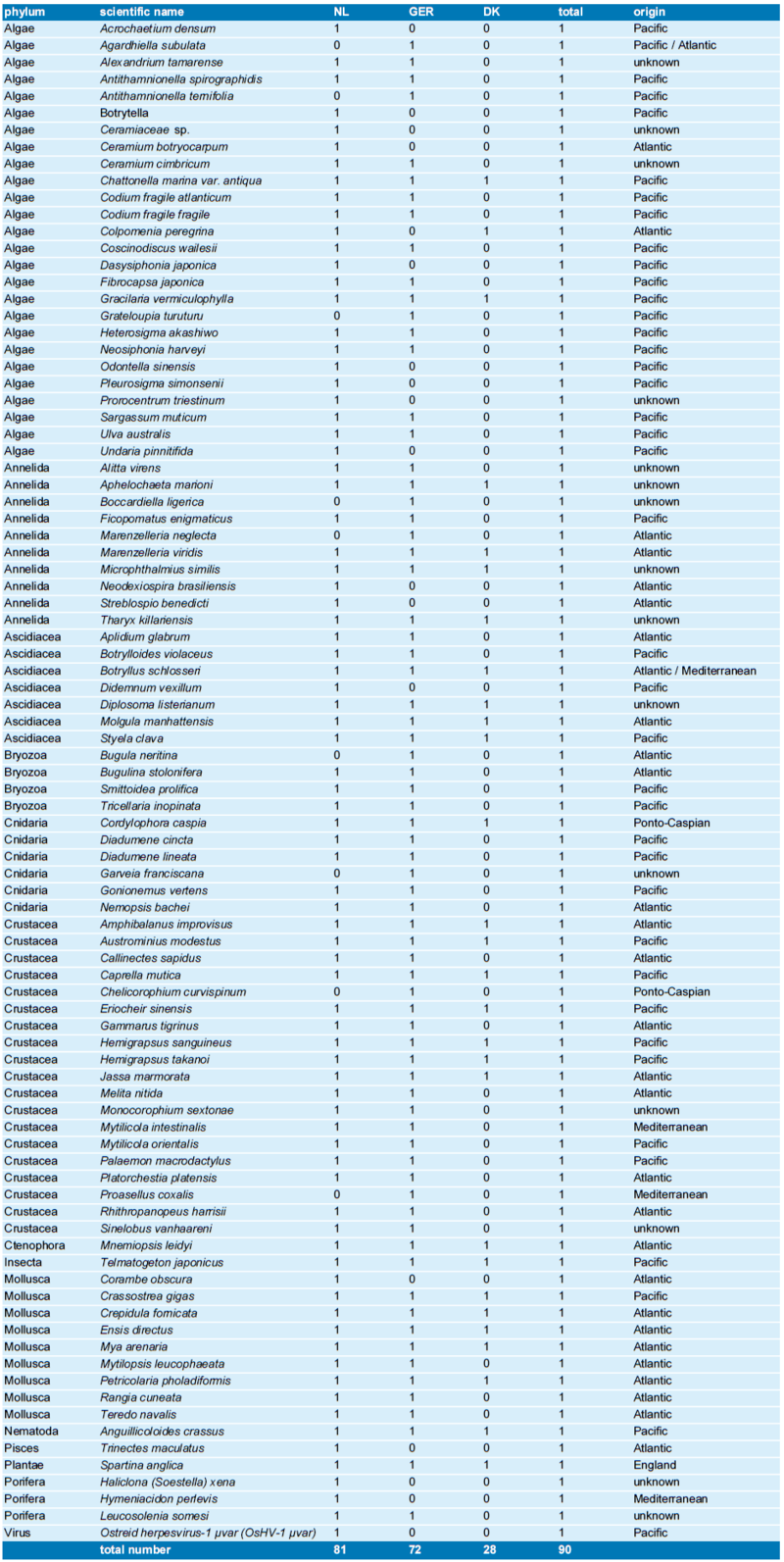Annex "Alien species"
More
European webpages and information
EASIN – European Alien Species Information Network: http://easin.jrc.ec.europa.eu/
Delivering Alien Invasive Species Inventories for Europe (DAISIE) : http://www.europe-aliens.org/
European Network on Invasive Alien Species (NOBANIS): https://www.nobanis.org/
Trilateral webpages and information
Stade Declaration 1997: http://www.waddensea-secretariat.org/sites/default/files/images/stade-engl.pdf
Sylt Declaration 2010: http://www.waddensea-secretariat.org/sites/default/files/downloads/sylt-md-complete-final-11-02-08-web.pdf
Tønder Declaration 2014: http://www.waddensea-secretariat.org/sites/default/files/Meeting_Documents/Conference2014/council_declaration_-_draft_12_dec_2013_clean_final.pdf
Trilateral Wadden Sea Plan 2010: http://www.waddensea-secretariat.org/sites/default/files/downloads/wsp-v2-11-02-03-final-lowres.pdf
Nehring et al. 2009: Alien Species, Quality Status Report 2009: http://www.waddensea-secretariat.org/sites/default/files/downloads/07-alien-species-09-11-20.pdf
Bouma et al. (2011): http://www.waddensea-secretariat.org/sites/default/files/images/neobiota_final_report_22th_of_november_2011_3.pdf
Schuchardt & Scholle (2015): http://www.waddensea-secretariat.org/sites/default/files/downloads/Folkert_downloads/14-687_as_policies_and_management_wadden_sea_final_verkleind.pdf
van der Have et al. (2015): http://www.waddensea-secretariat.org/sites/default/files/downloads/Folkert_downloads/p606_cwss_ias_finalreport_20150722.pdf
International Maritime Organisation: http://www.imo.org/en/About/Conventions/StatusOfConventions/Pages/Default.aspx
The Netherlands:
WaLTER ‘Wadden Sea Long-Term Ecosystem Research’: http://www.walterwaddenmonitor.org/
Germany:
Informationsportal des Bundesamtes für Naturschutz über gebietsfremde und invasive Arten in Deutschland : http://www.neobiota.de/
AWI North Sea Office: https://www.awi.de/forschung/besondere-gruppen/nordseebuero/neobiota-meldestelle.html
Denmark:
Monitoring of non-indigenous species in Danish marine waters: http://naturstyrelsen.dk/media/132530/nst-monis-report-final.pdf
Trends in records and contribution of non-indigenous species (NIS) to biotic communities in Danish marine waters: http://dce2.au.dk/pub/SR179.pdf
Annex 1
Trilateral alien species list from Gittenberger (2016). Origin information is given in broad categories, for more details please check Buschbaum et al. (2015), Lackschewitz et al. (2015) and Gittenberger (2016). Detection is indicated with “1”, no detection is indicated with “0”. The column “total” refers to the entire Wadden Sea area.
Annex 2
Spartina anglica – invasive alien and/or beneficial ecosystem engineer?
Common Cordgrass (Spartina anglica) is a widespread species in Wadden Sea salt marshes. Here, it is considered as a pioneer plant, establishing itself on bare tidal flats. In addition, it also occurs in depressions within the low and high marsh zones (see QSR chapter on salt marshes). The plant has a unique evolutionary origin: It developed from Spartina × townsendii, which is a naturally derived and sterile hybrid between the European native cordgrass Spartina maritima (small cordgrass) and the introduced American Spartina alterniflora (smooth cordgrass). Spartina × townsendii was recognized for the first time around 1870 in Southern England, to where Spartina alterniflora was unintentionally introduced, probably by ballast water some decades earlier. The allotetraploid Spartina anglica evolved by chromosome doubling out of Spartina × townsendii and was observed close to Southampton less than 25 years after the first appearance of this hybrid.
In the early 20th century, Spartina anglica has been planted at several sites along the Wadden Sea coast because it was considered to help build up new salt marshes. As the species was naturally not occurring in the Wadden Sea and as it was introduced here by humans, it has been considered an alien species. However, natural dispersal distances of salt marsh plants by ocean currents are comparatively high and it could thus be hypothesized that the species today would also have naturally reached the Wadden Sea from its place of evolutionary origin, which is only some 500 km southwest from the Wadden Sea. This is challenging the consideration of Spartina anglica being an alien plant in the Wadden Sea. Spartina anglica was also introduced to coastlines in Asia, Australia, New Zealand and North America, areas far away from its place of evolutionary origin. Here, it is considered a serious invader of native coastal ecosystems. Consequently, the species is also listed by the World Conservation Union to be among the 100 ‘World’s Worst’ invaders (Lowe et al. 2000).
By oxygenizing its rhizosphere, by sediment trapping and increasing accretion rates and by contributing to the geomorphological development of newly establishing salt marshes in the Wadden Sea, Spartina anglica can also be considered as an important ecosystem engineer. For its establishment from seeds on bare tidal flats, it needs a certain ‘window of opportunity’, a period of time with comparatively low water levels allowing germination and establishment. Later on, the species develops into single tussocks which mainly grow by vegetative means and eventually merge and build dense Spartina swards. By lowering tidal currents within, but increasing them outside of tussocks, Spartina also determines the development of creeks in young pioneer marshes.
Spartina anglica is the dominant and characteristic species of the S. anglica vegetation type in the TMAP vegetation typology and of habitat H1320 (Spartina swards) of the European habitat directive (see also QSR chapter on salt marshes). It has not been proven and it is not expected that Spartina anglica is replacing native vegetation in Wadden Sea salt marshes in the sense that any native salt marsh plant might be prone by extinction due to the Spartina invasion. Although the species seems to speed up the development from tidal flats into salt marshes, this has to be considered also a natural process and in view of accelerating sea level rise in times of climate change the beneficial effects of Spartina seem to outweigh any anticipated possible negative impact.

